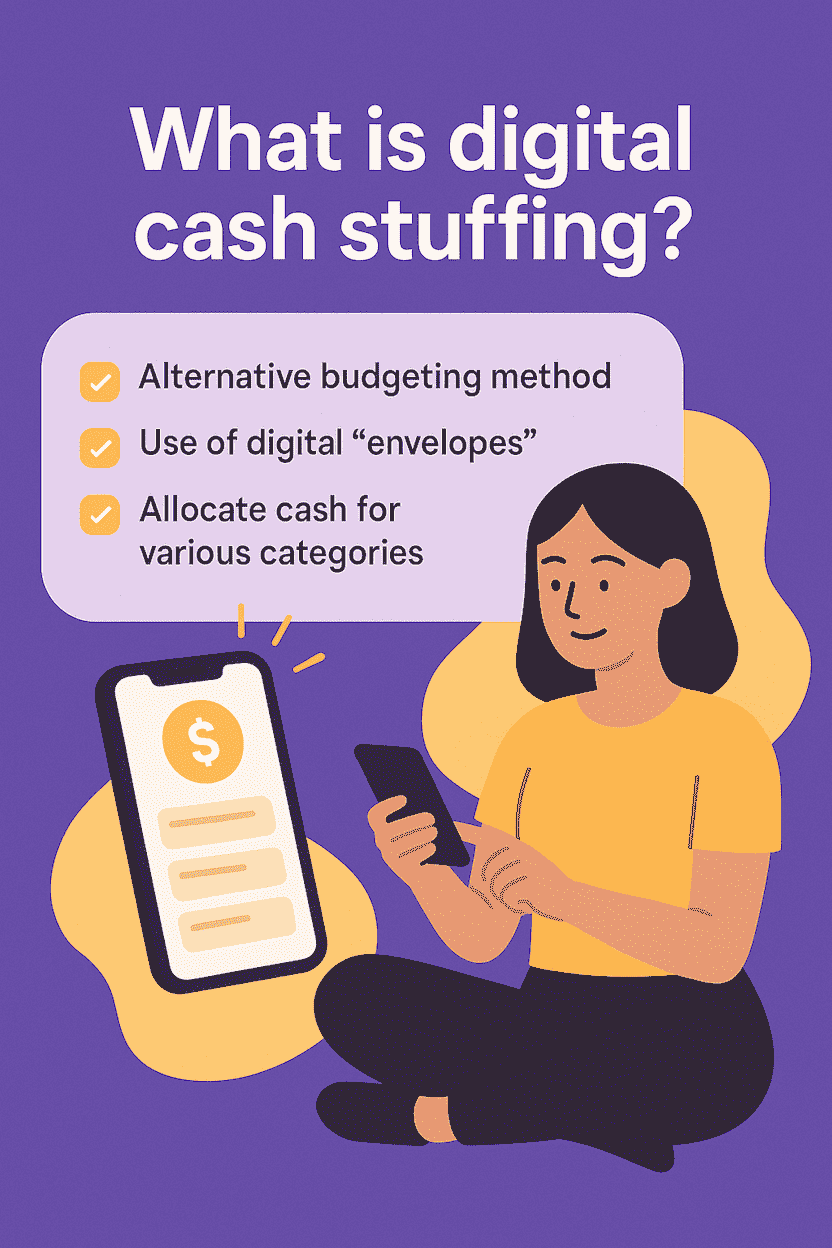Advertiser Disclosure
Last update: September 24, 2025
8 minutes read
Digital Cash Stuffing: The Modern Take on Envelope Budgeting That Actually Works
Those satisfying TikTok videos of people organizing cash into labeled envelopes look great, but who actually uses cash anymore?

By Derick Rodriguez, Associate Editor
Edited by Yerain Abreu, M.S.
Learn more about our editorial standards



By Derick Rodriguez, Associate Editor
Edited by Yerain Abreu, M.S.
Learn more about our editorial standards
Those aesthetic cash-stuffing videos have racked up nearly 820 million views on TikTok, but there's a disconnect here. Students are watching people sort physical money while paying for everything with cards or mobile payments.
Here's how to bridge that gap with digital cash stuffing; same proven method, zero trips to the ATM.

Key takeaways
- Digital cash stuffing takes the old envelope budgeting method and makes it work with apps, bank accounts, or spreadsheets instead of physical cash
- It helps students control spending, avoid debt, and see where their money goes, all while staying practical in a mostly cashless world
- The key is to start simple with a few categories, stay consistent, and adjust as your spending habits change
What is cash stuffing?
Cash stuffing, also called the envelope budgeting system, is where you portion out money into physical envelopes for different spending categories. It was really made famous by finance guru and radio talk show host Dave Ramsey, though he wasn't the first to use it.
It's a budgeting method your grandparents might have used that's resurfaced in recent years, going viral on TikTok thanks to creators like Jasmine Taylor, who used cash budgeting to climb out of debt and now runs a $2.2 million-a-year business called Baddies & Budgets.
The concept is simple: you get paid, withdraw cash, and stuff it into labeled envelopes, like "groceries," "gas," "entertainment." When an envelope's empty, you stop spending in that category. No credit cards, no overdrafts, just the cash you've allocated.
But here's the problem: according to a recent Credit Karma Report, almost 70% of Gen Z are using cash more now than they did 12 months ago, yet most students still do the majority of their spending digitally.

TuitionHero Tip
Start with just 3-4 categories when you're learning digital cash stuffing. Too many envelopes can feel overwhelming and lead to abandoned budgets.
What is digital cash stuffing?
Digital cash stuffing takes Dave Ramsey's proven envelope method and adapts it for our cashless world. Instead of physical envelopes with actual bills, you assign money to different spending categories using apps, spreadsheets, or separate bank accounts.
Think of your paycheck like a pizza you need to slice up. Your money stays in your bank account, but you decide ahead of time how much goes toward each spending category. Same psychological benefits, way more practical for how people actually spend money today.
The cash envelope system helps avoid the overdraft fees and debt that can come with frequent debit and credit card swiping, and the digital version keeps those same benefits while being usable everywhere cards are accepted.

Why students are using this strategy
College students barely touch cash anymore. Cash payments now represent only 16% of all transactions in 2024, and that number's probably even lower for students. By 2022, credit cards overtook cash as the most popular payment method, making up 30.77% of transactions.
Your meal plan goes on a student ID card, textbooks get ordered online, even campus coffee shops take Venmo. Trying to budget with physical cash when everything else is digital just doesn't make sense.
But here's the thing about keeping some cash around: Having a small amount of physical cash can be smart for emergencies, tips, or places that don't accept cards. Some financial experts suggest keeping $20-50 in actual cash for these situations.
Plus, there's psychological research showing that spending physical money feels more "real" than swiping cards, which can help with impulse control.
The visual aspect of digital systems helps too. Many apps show colorful progress bars or charts that make budgeting feel less like homework. When you can see your "textbook fund" running low, you'll think twice before buying another book you'll never read.

TuitionHero Tip
Set up automatic transfers if possible. Many banks let you automatically split direct deposits or move money between accounts on certain dates.
How to actually start digital cash stuffing
Don't overcomplicate it; that's where most people fail.
- Step 1 - Calculate your monthly income: Add up everything: part-time job wages, money from parents, financial aid refunds, side hustle earnings. This is your total to allocate.
- Step 2 - Choose your categories: Start simple with 4-5 main buckets:
- Necessities (food, gas, toiletries)
- School stuff (textbooks, supplies, printing)
- Fun money (entertainment, eating out)
- Irregular expenses (clothes, emergencies)
- Step 3 - Assign dollar amounts: Cover needs first, then split leftover money between wants and savings. Don't stress about getting it perfect initially—you'll adjust as you learn your spending patterns.
- Step 4 - Pick your tracking method: Choose one system and stick with it for at least a month. Whether it's a budgeting app, separate bank accounts, or a spreadsheet, consistency matters more than having the perfect setup.
- Step 5 - Check before you spend: This is crucial. Before any purchase, check your relevant "envelope" balance. If the money's not allocated there, either skip the purchase or move funds from another category.
Compare private student loans now
TuitionHero simplifies your student loan decision, with multiple top loans side-by-side.
Compare Rates
Tools that actually work for students
- Budgeting apps designed for envelope methods: GoodBudget, Mint, and Simplifi support the envelope system. Qube Money won Real Simple's Smart Money award for #1 budgeting app. These connect to your bank account and automatically track spending against your envelope limits.
- Your bank's built-in features: Some banks have envelope-style features. Ally Bank calls theirs "buckets," Capital One lets you create multiple savings accounts. Even if your bank doesn't have special features, you can open separate accounts for different spending categories.
- Simple spreadsheets: Don't overlook basic Google Sheets or Excel. Create columns for each spending category and track manually. It's free, accessible from your phone, and you can customize it however makes sense for your situation.
- Hybrid approaches: Many successful digital cash stuffers combine methods. Maybe you use an app for tracking but keep some money in separate bank accounts, or plan everything in a spreadsheet but use your bank's mobile alerts to stay on track.

TuitionHero Tip
Many students find success pairing digital cash stuffing with automatic transfers. Set up your bank to automatically move money into different savings accounts (your digital envelopes) each month.
Digital vs. traditional cash stuffing
Feature | Traditional Cash Stuffing | Digital Cash Stuffing |
|---|---|---|
Physical money needed | Yes, requires ATM trips | No cash required |
Setup complexity | Quick and simple | Varies by method chosen |
Where you can use it | Only cash-accepting places | Everywhere cards work |
Security | Can be stolen or lost | Protected by bank security |
Spending tracking | Count manually | Often automatic |
Moving money between categories | Difficult once stuffed | Easy digital transfers |
The biggest advantage of going digital is convenience. You can shop online, split dinner bills through payment apps, and still stick to your budget. But some people find that handing over physical cash makes spending feel more "real" psychologically.
If you miss that psychological effect, consider using a debit card with a low balance instead of your main account. Load it with your spending money each week to create similar constraints.
Common mistakes students make
- Overcomplicating the system: Students often start with too many categories and get overwhelmed. Begin with broad groups like "needs," "wants," and "savings." You can always break these down more once you're comfortable with the basic system.
- Forgetting irregular expenses: Your monthly budget needs room for textbooks, spring break, holiday gifts, and other expenses that don't happen regularly. Create "envelopes" for these things and contribute monthly so you're prepared when they come up.
- Not adjusting for academic life: Your spending changes throughout the semester. You might spend more on food during finals week and less on entertainment. Build flexibility into your system rather than using identical amounts every month.
- Ignoring small purchases: That $3 coffee or $5 snack might seem too small to track, but these add up quickly on a student budget. Make sure your system covers all types of regular spending.

TuitionHero Tip
If you miss the psychological impact of physical cash, try using a debit card with a low balance instead of your main account. Load it with your spending money each week to create a similar constraint.

Why trust TuitionHero
At TuitionHero, we help you find the best private student loans by comparing top lenders and breaking down eligibility, interest rates, and repayment options. Whether you need additional funding beyond federal aid or a loan without a cosigner, we simplify the process. We also provide expert insights on refinancing, FAFSA assistance, scholarships, and student credit cards to support your financial success.
Frequently asked questions (FAQ)
Yes. Track your envelope allocations in a spreadsheet, budgeting app, or notes app. The key is knowing how much you've allocated to each category and tracking spending against those limits.
You have options: move money from another envelope, accept less spending next month, or earn extra income to replenish it. The important thing is acknowledging the overspending instead of ignoring it.
Most successful users check allocations before any non-routine purchases, plus do a weekly review to see how they're tracking and make adjustments.
Yes, but you need extra discipline. When you use a credit card, immediately deduct the purchase amount from your appropriate digital envelope. Some people find it easier to stick with debit cards to avoid this complication.
Depends on your personality and situation. Digital cash stuffing works well for people who like clear boundaries and visual tracking. Students with very irregular income might prefer more flexible approaches.
Final thoughts
Digital cash stuffing works because it fixes the main problems with traditional budgeting. It gives you clear boundaries without the inconvenience of carrying cash everywhere. You get the psychological benefits of the envelope system with the practical advantages of digital banking.
Whether you use a sophisticated app or a simple spreadsheet, the key is having a system that matches how you actually spend money. Start simple, stay consistent, and adjust as you learn what works for your lifestyle.
The best budgeting system is the one you'll actually use. If digital cash stuffing provides the structure and awareness you need to build better money habits, it's worth trying, especially when combined with resources like TuitionHero to help maximize your available funds.
Source
Author

Derick Rodriguez
Derick Rodriguez is a seasoned editor and digital marketing strategist specializing in demystifying college finance. With over half a decade of experience in the digital realm, Derick has honed a unique skill set that bridges the gap between complex financial concepts and accessible, user-friendly communication. His approach is deeply rooted in leveraging personal experiences and insights to illuminate the nuances of college finance, making it more approachable for students and families.
Editor

Yerain Abreu
Yerain Abreu is a Content Strategist with over 7 years of experience. He earned a Master's degree in digital marketing from Zicklin School of Business. He focuses on college finance, a niche carved out of his journey through the complexities of academic finance. These firsthand experiences provide him with a unique perspective, enabling him to create content that's informative and relatable to students and their families grappling with the intricacies of college financing.
At TuitionHero, we're not just passionate about our work - we take immense pride in it. Our dedicated team of writers diligently follows strict editorial standards, ensuring that every piece of content we publish is accurate, current, and highly valuable. We don't just strive for quality; we aim for excellence.
Related posts
While you're at it, here are some other college finance-related blog posts you might be interested in.
Shop and compare student financing options - 100% free!

Always free, always fast
TuitionHero is 100% free to use. Here, you can instantly view and compare multiple top lenders side-by-side.

Won’t affect credit score
Don’t worry – checking your rates with TuitionHero never impacts your credit score!

Safe and secure
We take your information's security seriously. We apply industry best practices to ensure your data is safe.
Finished scrolling? Start saving & find your private student loan rate today
Compare Personalized Rates


